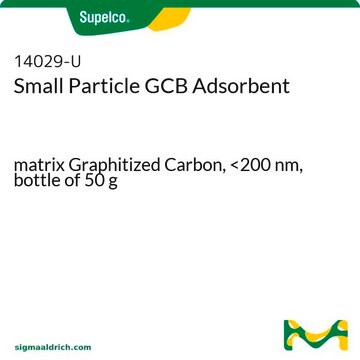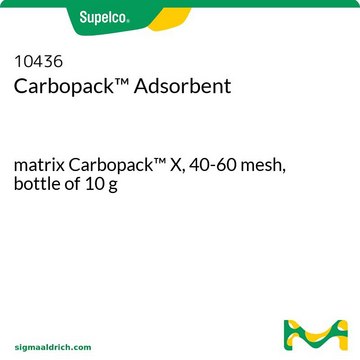11047-U
Carbotrap® Carbon Adsorbent
matrix Carbotrap® C, 20-40 mesh, bottle of 500 g
About This Item
Productos recomendados
Nombre del producto
Carbotrap® Adsorbent, matrix Carbotrap® C, 20-40 mesh, bottle of 500 g
product line
Carbotrap®
Quality Level
form
granular
packaging
bottle of 500 g
technique(s)
LPLC: suitable
gas chromatography (GC): suitable
surface area
~10 m2/g
matrix
Carbotrap® C
matrix active group
carbon
particle size
20-40 mesh
pore size
~0 cm3/g macroporosity
~0 cm3/g mesoporosity
~0 cm3/g microporosity
~0 Å pore diameter
bulk density
~0.70 g/mL (free fall density)
separation technique
reversed phase
¿Está buscando productos similares? Visita Guía de comparación de productos
Categorías relacionadas
General description
- Granular
- Friable
- Used for molecules with an analyte size relative to C3-C20+ n-alkanes
- Hydrophobic (can be used in high humidity environments)
Generally, GCB adsorbents offer weaker relative adsorptive strength compared to carbon molecular sieve (CMS) adsorbents, and similar relative adsorptive strength compared to spherical graphitized polymer carbon (SGPC) adsorbents. Our Carbotrap products are a type of GCB adsorbent.
- Particles are 20/40 mesh
- These large particles allow high flow rates without excessive pressure drops
For more information about any of our specialty carbon adsorbents, please visit sigma-aldrich.com/carbon
Legal Information
Storage Class
11 - Combustible Solids
wgk_germany
nwg
flash_point_f
Not applicable
flash_point_c
Not applicable
ppe
Eyeshields, Gloves, type P3 (EN 143) respirator cartridges
Elija entre una de las versiones más recientes:
Certificados de análisis (COA)
It looks like we've run into a problem, but you can still download Certificates of Analysis from our Documentos section.
Si necesita más asistencia, póngase en contacto con Atención al cliente
¿Ya tiene este producto?
Encuentre la documentación para los productos que ha comprado recientemente en la Biblioteca de documentos.
Artículos
Carbon Molecular sieves (CMS) are a versatile range of adsorbents that can be tailored for specific applications. Supelco® scientists have been synthesizing synthetic CMS carbons for several decades, starting from tailoring of the starting polymers/copolymers, to modifying the final properties of the subsequent CMS carbon.
Global Trade Item Number
| Número de referencia del producto (SKU) | GTIN |
|---|---|
| 11047-U | 4061833535011 |
Nuestro equipo de científicos tiene experiencia en todas las áreas de investigación: Ciencias de la vida, Ciencia de los materiales, Síntesis química, Cromatografía, Analítica y muchas otras.
Póngase en contacto con el Servicio técnico







